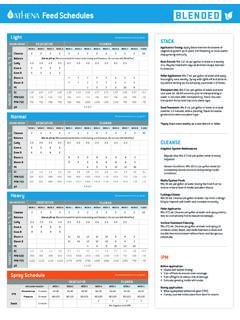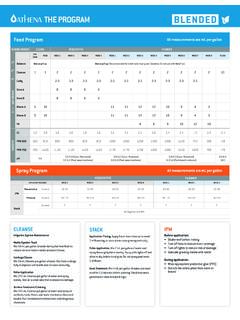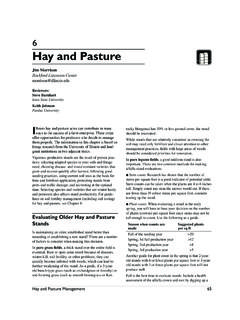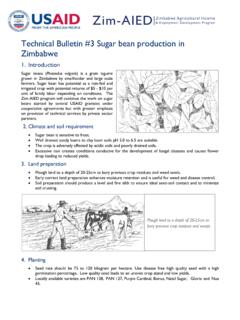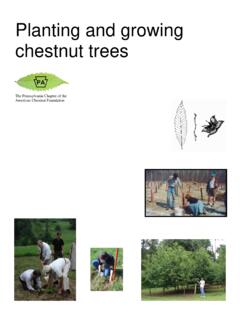Transcription of Botany Basics - Oregon State University
1 Botany Basics 1. P. lants are essential to life on earth. Either directly or indirectly, they are the primary food source for humans and other animals. Additionally, they provide fuel, replenish the earth's oxygen supply, prevent TOPICS IN THIS CHAPTER. soil erosion, slow down wind movement, cool the atmo- sphere, provide wildlife habitat, supply medicinal com- Plant life cycles pounds, and beautify our surroundings. Internal plant parts Many plants are familiar to us, and we can identify and External plant parts appreciate them based on their external structures.
2 However, their internal structures and functions often are Plant growth and overlooked. Understanding how plants grow and develop development helps us capitalize on their usefulness and make them Environmental factors part of our everyday lives. affecting growth This chapter focuses on vascular plants those that contain water-, nutrient-, and food-conducting tissues Plants in communities called xylem and phloem. Ferns and seed -producing Plant hormones and plants fall into this category. growth regulators In several cases, we will distinguish between monocoty- ledonous and dicotyledonous plants.
3 Sometimes called monocots and dicots for short, these plants have several important distinguishing characteristics. For example, monocots ( , grasses) produce only one seed leaf, while dicots (broadleaf plants) have two. The vascular systems, flowers, and leaves of the two types of plants By Ann Marie VanDerZanden, Extension also differ (Table 1). These differences will be important master gardener State coordinator, Oregon in our discussion of plant growth and development. State University . Table 1. Comparison between monocots and dicots.
4 Structure Monocots Dicots seed leaves one two Vascular system Xylem and phloem are paired in bundles, Xylem and phloem form rings inside the stem. which are dispersed throughout the stem. The phloem forms an outer ring, the xylem an inner ring. Floral parts Usually in threes or multiples of three. Usually in multiples of four or five. Leaves Often parallel-veined. Generally net-veined. 4 Botany Basics Chapter 1. Botany terminology Monocot Having one seed leaf. Anther The pollen sac on a male flower. Node An area on a stem where a leaf, Apex The tip of a shoot or root.
5 Stem, or flower bud is located. Apical dominance The tendency of an Ovary The part of a female flower apical bud to produce hormones that where eggs are located. suppress growth of buds below it on Petiole The stalk that attaches a leaf to the stem. a stem. Axil The location where a leaf joins a Phloem Photosynthate-conducting stem. tissue. Cambium A layer of growing tissue that Photosynthate A food product (sugar separates the xylem and phloem and or starch) created through photo- continuously produces new xylem and synthesis.
6 Phloem cells. Photosynthesis The process in green Chlorophyll The green pigment in plants of converting carbon dioxide leaves that is responsible for trapping and water into food (sugars and light energy from the sun. starches) using energy from sunlight. Chloroplast A specialized component of Pistil The female flower part; consists of certain cells; contains chlorophyll and a stigma, style, and ovary. is responsible for photosynthesis. Respiration The process of converting Cortex Cells that make up the primary sugars and starches into energy.
7 Tissue of the root and stem. Stamen The male flower part; consists Cotyledon The first leaf that appears on of an anther and a supporting filament. a seedling. Also called a seed leaf. Stigma The top of a female flower part;. Cuticle A relatively impermeable collects pollen. surface layer on the epidermis of leaves Stoma (pl. stomates, stomata) Tiny and fruits. openings in the epidermis that allow Dicot Having two seed leaves. water, oxygen, and carbon dioxide to Epidermis The outermost layer of plant pass into and out of a plant.
8 Cells. Style The part of the female flower that Guard cell Epidermal cells that open connects the stigma to the ovary. and close to let water, oxygen, and Pollen travels down the style to reach carbon dioxide pass through the the ovary, where fertilization occurs. stomata. Transpiration The process of losing Internode The space between nodes on water (in the form of vapor) through a stem. stomata. Meristem Specialized groups of cells Turgor Cellular water pressure;. that are a plant's growing points. responsible for keeping cells firm.
9 Mesophyll A leaf's inner tissue, located Vascular tissue Water-, nutrient-, and between the upper and lower photosynthate-conducting tissue epidermis; contains the chloroplasts (xylem and phloem). and other specialized cellular parts Xylem Water- and nutrient-conducting (organelles). tissue. Chapter 1 Botany Basics 5. Plant life cycles grow from the plant's crown each spring. Trees and shrubs, on the Based on its life cycle, a other hand, have woody stems plant is classified as either that withstand cold winter an annual, biennial, or temperatures.
10 They are perennial. referred to as woody perenni- An annual, such as a als. zinnia, completes its life cycle in 1 year. Annuals are said to go Internal plant parts from seed to seed in 1 year Cells are the basic structural or growing season. During and physiological units of plants. this period, they germinate, Most plant reactions (cell division, grow, mature, bloom, produce photosynthesis, respiration, etc.) occur at seeds, and die. Summer annuals the cellular level. Plant tissues (meristems, complete their life cycle during spring and xylem, phloem, etc.)
